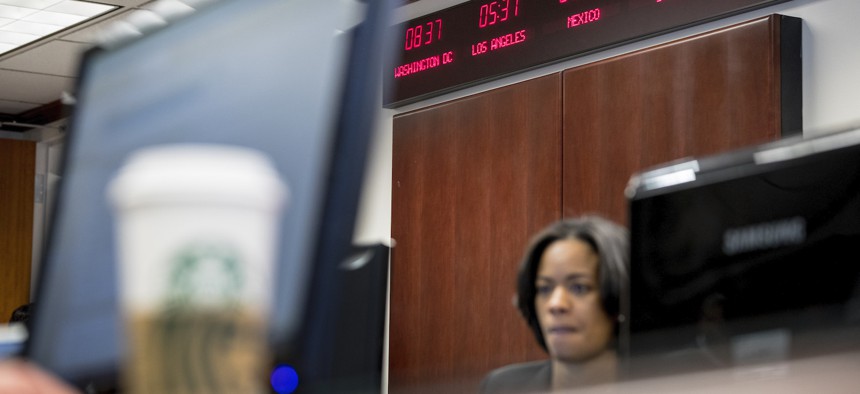
Digital clocks from different time zones around the world are displayed above Drug Enforcement Administration agents and intelligence analysts gathering information from field operations across the country at their command center. March 11, 2020 AP Photo/Andrew Harnik
Weird Hours, Contractor Concerns: How the Intelligence Community Is Grappling with Coronavirus
Intelligence agencies are trying to adapt to social distancing guidelines, but that’s leaving many employees and contractors in limbo.
Like any other vital institution, the U.S. intelligence community is grappling with the disruptive effects of the coronavirus — including unconventional working hours and uncertainty among the employee and contractor work forces.
At NSA and CIA, some departments and functions have adjusted schedules and adopted unconventional working hours in a bid to implement social-distancing measures while fulfilling their missions. Some employees who used to work regular hours are now working in shifts, such as three days on and three days off, or one week on and one week off, etc., sources within the intelligence community told Defense One.
Spokespeople for the CIA and the NSA declined to say whether full-time employees or contractors were working diminished hours or in altered shifts. But they did say that any changes they might have made had not hurt their ability to carry out critical intelligence activities.
“Given CIA’s unique mission, we’re always prepared to preserve our mission capability, no matter the circumstances, while also protecting the well-being of our global workforce. In response to COVID-19, our officers are exercising tremendous creativity and flexibility, and we’re delivering on our mission,” a CIA spokesperson told Defense One in an email.
“NSA maintains and rehearses comprehensive plans to remain effective and achieve our missions across a variety of challenging situations,” an NSA spokesperson said. “We continue to monitor the potential risks presented by COVID-19, and are taking appropriate steps such as workplace distancing and increased cleaning to ensure NSA’s people remain safe, secure, and healthy without impacting our operational capabilities.”
The pandemic is also affecting the large group of contractors who serve the intelligence community. Many have found themselves in a difficult situation because their contracts require them to work in a specific Sensitive Compartmented Information Facility, or SCIF — a generally small facility that is built to keep invasive signals intelligence collection out. In fact, a lot of work that deals with open source or even unclassified material still usually occurs in classified settings, simply because that’s common practice now, according to an intelligence community contractor who spoke to Defense One.
The new work schedules are also causing confusion among contractors who wonder whether they will be paid for working shifts, part-time, or not at all. There’s been no detailed IC-wide guidance about this to agencies, and little given by agencies to contracting officers, the contractor said.
From where should that guidance come? Probably the Office of the Director of National Intelligence, or ODNI, according to retired CIA officer John Sipher. He called that contractor confusion “exactly the kind of thing the DNI should be dealing with. It impacts the entire IC.” ODNI has put out a letter on the subject but the relevant portion, on section 3610 of the CARES Act, still leaves big questions unanswered said the contractor.
The ODNI could, for example, tell agencies that contractors should get their full wages even if they can’t work where the contract says they should. Or it could tell them to allow workers to work from company SCIFs, or adopt other solutions.
One problem is that the ODNI has not had a Senate-confirmed director since Dan Coats left last August. In February, the President nominated Rep. John Ratcliffe, R-TX, for the position, but he hasn’t yet been confirmed by the Senate.
According to a March 21 letter from the Intelligence and National Security Alliance, the risks of not compensating contractual intelligence workers could decimate the so-called “Trusted Workforce.” The community could lose people that it needs both now and in the future.
“Agencies have begun to send both government and contract staff home and are considering limiting the number of workers who can come to government facilities for as long as eight weeks,” notes the letter. “The number of cleared contractors alone is about 500,000 – and they are supported by thousands more colleagues who do not require a clearance. If these contract employees cannot continue working during the COVID crisis, there is a significant risk that they will not rejoin the Trusted Workforce when the crisis is over, leaving the national security industrial baseless able to support critical government missions”
Of course, the other thing that the intelligence community could do to make it easier to retain top talent during a period of unusual work-from-home arrangements is reforming the clearance process. Less classified intelligence material means more material that analysts can work with at home or from other non-SCIF locations. Reforming that process means processing clearance applications for workers much faster, not classifying as much material, and ensuring that analysts work with non-classified material in non-classified settings, even if it eventually goes into a classified report or product. The problem of over-classification of intelligence is one national security leaders have been highlighting with increasing urgency.
Bottom line: it may well take a massive global disaster to bring the intelligence community into the new era. But it could lose important talent along the way.
NEXT STORY: The Pentagon Is Using Zoom. Is it Safe?




